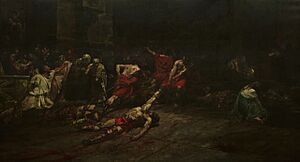Spoliarium facts for kids
Quick facts for kids Spoliarium |
|
|---|---|
 |
|
| Artist | Juan Luna |
| Year | 1884 |
| Medium | Oil on canvas |
| Dimensions | 4.22 m × 7.675 m (13.8 ft × 25.18 ft) |
| Location | National Museum of Fine Arts, Manila |
The Spoliarium is a very famous painting by the Filipino artist Juan Luna. He spent eight months painting it on a large canvas. The painting shows a scene from an ancient Roman circus, where dead gladiators are being stripped of their armor and clothes after a fight.
Juan Luna sent his painting to an art show in Madrid, Spain, in 1884. It won the first gold medal, which was a huge honor! The Spoliarium was also shown in Rome in April 1884.
In 1886, the painting was sold to the government of Barcelona, Spain. Today, you can see the Spoliarium in the National Museum of Fine Arts in Manila, Philippines. It is the first artwork visitors see when they enter the museum. The museum says it is the biggest painting in the Philippines, measuring about 4.22 meters tall and 7.675 meters wide.
Contents
Other Versions of the Painting
Did you know there isn't just one Spoliarium? Art experts Ambeth Ocampo and Santiago Albano Pilar say there are at least four known versions of this famous painting. The biggest one is the 1884 painting you can see in the National Museum.
Two smaller versions are owned by private collectors. Another version was made for a Russian nobleman, but its location is currently unknown.
The Spoliarium Sketch
In 2018, a special sketch or "boceto" (pronounced boh-SEH-toh) of the Spoliarium was found after almost 125 years! This sketch is thought to be the very first version of the painting, made in 1883. It even has "SPOLIARIVM - boceto LVNA, R[OMA], 1883" written on it.
This early sketch also has a unique signature by Luna. He wrote "BU LA[N]" in an old Filipino writing style called baybayin. This word means "moon" in the Ilocano language, and Luna only added it to a few of his artworks.
Where the Sketch Was Found
The boceto was last shown to the public in 1893 at a museum in Madrid, Spain. Later research showed that it was once owned by Pedro Paterno, a Filipino politician who was a good friend and supporter of Juan Luna.
The painting then ended up with a family in Spain for nearly 130 years. It was sold for a record price of about 73.584 million Philippine pesos (which is about 1.36 million US dollars) at an art auction in the Philippines.
Images for kids
See also
 In Spanish: Spoliarium para niños
In Spanish: Spoliarium para niños


